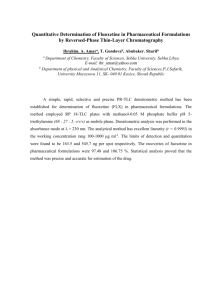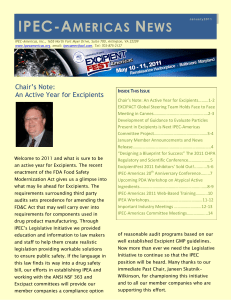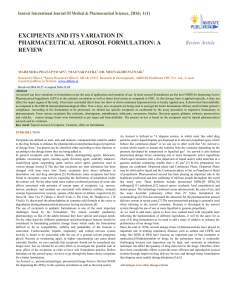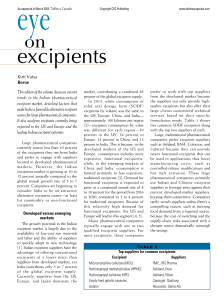IPEC Foundation Announces 2014 Best Manuscript
advertisement
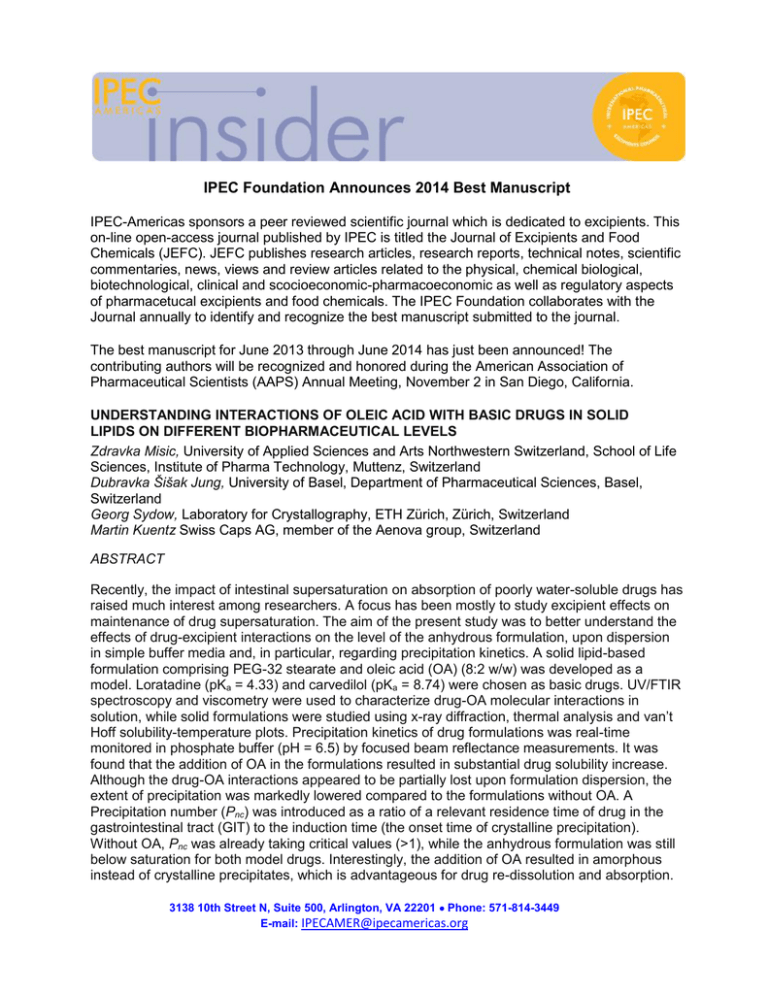
IPEC Foundation Announces 2014 Best Manuscript IPEC-Americas sponsors a peer reviewed scientific journal which is dedicated to excipients. This on-line open-access journal published by IPEC is titled the Journal of Excipients and Food Chemicals (JEFC). JEFC publishes research articles, research reports, technical notes, scientific commentaries, news, views and review articles related to the physical, chemical biological, biotechnological, clinical and scocioeconomic-pharmacoeconomic as well as regulatory aspects of pharmacetucal excipients and food chemicals. The IPEC Foundation collaborates with the Journal annually to identify and recognize the best manuscript submitted to the journal. The best manuscript for June 2013 through June 2014 has just been announced! The contributing authors will be recognized and honored during the American Association of Pharmaceutical Scientists (AAPS) Annual Meeting, November 2 in San Diego, California. UNDERSTANDING INTERACTIONS OF OLEIC ACID WITH BASIC DRUGS IN SOLID LIPIDS ON DIFFERENT BIOPHARMACEUTICAL LEVELS Zdravka Misic, University of Applied Sciences and Arts Northwestern Switzerland, School of Life Sciences, Institute of Pharma Technology, Muttenz, Switzerland Dubravka Šišak Jung, University of Basel, Department of Pharmaceutical Sciences, Basel, Switzerland Georg Sydow, Laboratory for Crystallography, ETH Zürich, Zürich, Switzerland Martin Kuentz Swiss Caps AG, member of the Aenova group, Switzerland ABSTRACT Recently, the impact of intestinal supersaturation on absorption of poorly water-soluble drugs has raised much interest among researchers. A focus has been mostly to study excipient effects on maintenance of drug supersaturation. The aim of the present study was to better understand the effects of drug-excipient interactions on the level of the anhydrous formulation, upon dispersion in simple buffer media and, in particular, regarding precipitation kinetics. A solid lipid-based formulation comprising PEG-32 stearate and oleic acid (OA) (8:2 w/w) was developed as a model. Loratadine (pKa = 4.33) and carvedilol (pKa = 8.74) were chosen as basic drugs. UV/FTIR spectroscopy and viscometry were used to characterize drug-OA molecular interactions in solution, while solid formulations were studied using x-ray diffraction, thermal analysis and van’t Hoff solubility-temperature plots. Precipitation kinetics of drug formulations was real-time monitored in phosphate buffer (pH = 6.5) by focused beam reflectance measurements. It was found that the addition of OA in the formulations resulted in substantial drug solubility increase. Although the drug-OA interactions appeared to be partially lost upon formulation dispersion, the extent of precipitation was markedly lowered compared to the formulations without OA. A Precipitation number (Pnc) was introduced as a ratio of a relevant residence time of drug in the gastrointestinal tract (GIT) to the induction time (the onset time of crystalline precipitation). Without OA, Pnc was already taking critical values (>1), while the anhydrous formulation was still below saturation for both model drugs. Interestingly, the addition of OA resulted in amorphous instead of crystalline precipitates, which is advantageous for drug re-dissolution and absorption. 3138 10th Street N, Suite 500, Arlington, VA 22201 Phone: 571-814-3449 E-mail: IPECAMER@ipecamericas.org In conclusion, this study provides an improved understanding of OA and basic drug interactions on different levels of in vitro performance for more rational oral formulation development. Click here to visit the Journal of Excipients and Food Chemicals and to read the full manuscript! Other IPEC Foundation Winners for 2014: The winner of the Louis Blecher Outstanding Lifetime Achievement Award is: Henk de Jong, Scientific Secretary of FIP, the International Pharmaceutical Federation. Henk de Jong studied chemistry and physics at Leiden University, the Netherlands, where he obtained an MSc (1970, cum laude) with a major in analytical chemistry. This was followed by a PhD (1973, cum laude) on Hyphenated Chromatographic-Spectrometric Techniques. Professor de Jong held positions in University (analytical chemistry, pharmaceutical quality) and industry (pre-clinical development, regulatory affairs) and was involved in activities at the Dutch, French and European Pharmacopoeias (last as Chair of the European Pharmacopoeia Commission 2007-2010). He was also one of the founding fathers of IPEC Europe (2 times chairman and many years of board-membership). The winner of the Ralph Shangraw Memorial Award is: Paolo Columbo, Ph.D., Professor of Pharmaceutics, University of Parma. Dr. Columbo received his PharmD in 1968 from the University of Pavia, Italy, PhD in Pharmacy. He started University of Pavia, Fellowship holder in 1970 until 1986 as Associate Professor. This was followed by University of Parma in 1986 as Full Professor until 2012 as Senior Member, Department of Pharmacy. Most recently he started a new line of research dedicated to the powder for inhalation and also to pressurized meter dosed inhalers. In this field the use of excipients is critical since the number of them approved is very low. The use of excipients in his scientific work is extremely innovative resulting in many patents filed on drug formulation (over 40), several of them with pharmaceutical companies. The winner of the Industry Research Achievement in Excipient Technology Award: Ali Rajabi-Siahboomi, Ph.D., VP & Chief Scientific Officer, Colorcon. He obtained his B.Pharm & Ph.D. in Pharmacy from University of Nottingham (UK). His main research interests are in the area of solid dosage from pharmaceutics and pharmaceutical technology with emphasis on oral drug delivery systems. The majority of his research focused on the development, characterization and application of various excipients for oral dosage form. Five Graduate Student Scholarships have been awarded to the following individuals: Mr. Zhonggiang (Jacky) Lin, University of Maryland: Quantification of the Extent of Coalescence of Ethylcellulose Films using Permeability and Spectroscopic Methods – Purpose: To use the water vapor permeability of ethylcellulose (EC) pseudolatex cast films at different stages of coalescence during the curing process to quantify the extent of particle coalescence. Mr. Desai Parind Mahendrakumar, National University of Singapore: Evaluation of 3138 10th Street N, Suite 500, Arlington, VA 22201 Phone: 571-814-3449 E-mail: IPECAMER@ipecamericas.org functionality of disintegrants and their mixtures by visiometric, calorimetric and quality by design approaches – Purpose: To evaluate functionality of disintegrants and their mixtures by visiometric, calorimetric and quality by design (QbD) approaches. Mr. Sharad Mangal, Monash University: Engineering of novel core-shell micro- excipient for efficient tablet manufacturing: Employing the concept of interactive mixing – Purpose: The term “interactive mixing” describes coating of larger particles with smaller ones of appropriate cohesive-adhesive balance. Ms. Pinal Mistry, University of Minnesota: Role of the strength of drug-polymer interactions on the molecular mobility and physical stability of amorphous solid dispersions – Purpose: To investigate the effect of specific drug-polymer interactions (ionic or H-bonding) on the molecular mobility and the physical stability of ketoconazole solid dispersions. Mr. Frederick Osei-Yeboah, University of Minnesota: Effect of moisture on the tableting performance of polymer-based drug delivery systems – Purpose: This work investigates the impact of moisture on mechanical properties of polymer-based pharmaceutical materials and their tableting performance. Graduate Student Scholarship winners will receive a travel award of $1,000 and membership with IPEC-Americas for one year. In addition, the scholarship winners will present their research during the poster sessions at AAPS November 3-5. 3138 10th Street N, Suite 500, Arlington, VA 22201 Phone: 571-814-3449 E-mail: IPECAMER@ipecamericas.org



